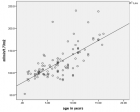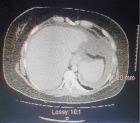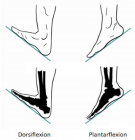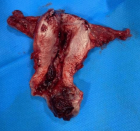Abstract
Research Article
Value of electrocardiographic T wave inversion in lead aVL in prediction of Mid Left Anterior Descending Stenosis in patients with stable Coronary Artery disease
Gehan Magdy* and Awad Yousef
Published: 18 August, 2017 | Volume 2 - Issue 1 | Pages: 056-062
Background: The electrocardiogram (ECG) is a simple and noninvasive bedside diagnostic tool with a well-established role in the diagnosis of coronary artery disease (CAD). We aimed to study the diagnostic value of electrocardiographic ST-T wave changes in lead aVL in prediction of site of coronary artery stenosis in patients with chronic stable angina.
Patients and Methods: study was conducted on 156 patients referred for invasive coronary angiography with history of stable CAD as proved by non- invasive tests, 12 lead ECG was recorded and fully interpreted with more focus on T wave direction in aVL lead. T waves in aVL were categorized into one of three groups: upright, flat or inverted.
Results: regarding T wave in lead aVL, inverted T wave was reported in 71(45.5%) patients, 58 (37.2%) patients were with upright T wave in lead aVL and 27(17.3%) patients were with flat T wave in lead aVL, and we found that inverted T wave in lead aVL was most evident in 56(73.7%) patients with mid LAD with (highest κ value equal to 0.550[moderate agreement], and p value<0.001.
Conclusions: This study confirmed the diagnostic value of T wave inversion in lead aVL in prediction of mid left anterior descending artery lesions in patients with stable coronary artery disease.
Read Full Article HTML DOI: 10.29328/journal.jccm.1001015 Cite this Article Read Full Article PDF
Keywords:
T wave inversion; Left anterior descending artery; Stable coronary artery disease
References
- Gaziano JM, Manson J, Ridker PM. A Textbook of Cardiovascular Medicine 8th ed Philadelphia, PA: Saunders Elsevier. 2007.
- Mensah GA, Brown DW. An overview of cardiovascular disease burden in the United States. Health Aff (Millwood). 2007; 26: 38-48. Ref.: https://goo.gl/Ay6Fff
- Masood Ali Akbar, Imran Waheed, Salman Munir, Shahid Amin, Nadeem Hayat Mallick. Study of electrocardiographic t wave inversion in patients with tight mid left anterior descending artery stenosis. Cardiovasc Dis. 2014; 12: 30-32.
- Nyman I, Areskog M, Areskog NH, Swahn E, Wallentin L. The RISC Study Group. Very early risk stratification by electrocardiogram at rest in men with suspected unstable coronary heart disease. J Intern Med. 1993; 234: 293-301. Ref.: https://goo.gl/J34NZQ
- Okada M, Yotsukura M, Shimada T, Ishikawa K. Clinical implications of isolated T wave inversion in adults: electrocardiographic differentiation of the underlying causes of this phenomenon. J Am Coll Cardiol. 1994; 24: 739-745. Ref.: https://goo.gl/LbLea3
- De Zwaan C, Bär FW, Wellens HJ. Characteristic electrocardiographic pattern indicating a critical stenosis high in left anterior descending coronary artery in patients admitted because of impending myocardial infarction. Am Heart J. 1982; 103: 730-736. Ref.: https://goo.gl/FbfUVC
- Rhinehardt J, Brady WJ, Perron AD, Mattu A. Electrocardiographic manifestations of Wellens’ syndrome. Am J Emerg Med. 2002; 20: 638-643. Ref.: https://goo.gl/q7ZhNQ
- Chatterjee K, Harris A, Davies G, Leatham A. Electrocardiographic changes subsequent to artificial ventricular depolarization. Br Heart J. 1969; 31: 770-779. Ref.: https://goo.gl/yGNn9z
- Gorgels AP, Vos MA, Mulleneers R, De Zwaan C, Bär FW, et al. Value of the electrocardiogram in diagnosing the number of severely narrowed coronary arteries in rest angina pectoris. Am J Cardiol. 1993; 72: 999-1003. Ref.: https://goo.gl/Piw9km
- Engelen DJ, Gorgels AP, Cheriex EC, De Muinck ED, Ophuis AJ, Dassen WR, et al. Value of the electrocardiogram in localizing the occlusion site in the left anterior descending coronary artery in acute anterior myocardial infarction. J Am CollCardiol. 1999; 34: 389-395. Ref.: https://goo.gl/n9EjpY
- Tamura A, Kataoka H, Mikuriya Y, Nasu M. Inferior ST segment depression as a useful marker for identifying proximal left anterior descending artery occlusion during acute anterior myocardial infarction. Eur Heart J. 1995; 16: 1795-1799. Ref.: https://goo.gl/bjJB7J
- Hassen GW, Costea A, Smith T, Carrazco C, Hussein H, et al. The neglected lead on electrocardiogram: T wave inversion in lead aVL, nonspecific finding or a sign for left anterior descending artery lesion? J Emerg Med. 2014; 46: 165-170. Ref.: https://goo.gl/CEaEid
- Farhan HL, Hassan KS, Al-Belushi A, Sallam M, Al-Zakwani I. Diagnostic Value of Electrocardiographic T Wave Inversion in Lead aVL in Diagnosing Coronary Artery Disease in Patients with Chronic Stable Angina.Oman Med J.2010; 25: 124-127. Ref.: https://goo.gl/kvJmjf
- Jukema JW, Vliegen HW, Bruschke AVG. Coronary angiography: principles, technique and interpretation. 1e druk, Leiden, the Netherlands, 2009. Chapter 3: 23-34.
- Zimetbaum PJ, Josephson ME. Use of the electrocardiogram in acute myocardial infarction. New England Journal of Medicine. 2003; 348: 933-940.
- Goldberger AL. Clinical Electrocardiography: A Simplified Approach, 7th ed. St. Louis, Mosby/Elsevier 2006.
- Quyyumi AA, Crake T, Rubens MB, Levy RD, Rickards AF, Fox KM. Importance of “reciprocal” electrocardiographic changes during occlusion of left anterior descending coronary artery. Studies during percutaneous transluminal coronary angioplasty. Lancet. 1986; 1: 347-350. Ref.: https://goo.gl/o7coq6
- Tamura A, Kataoka H, Mikuriya Y, Nasu M. Inferior ST segment depression as a useful marker for identifying proximal left anterior descending artery occlusion during acute anterior myocardial infarction. Eur Heart. J 1995; 16: 1795-1799. Ref.: https://goo.gl/dLcQpT
- Hanna EB, Glancy DL. ST-segment depression and T-wave inversion: classification, differential diagnosis, and caveats. Cleve Clin J Med. 2011; 78: 404-414. Ref.: https://goo.gl/mJZabJ
- Rashduni DL, Tannenbaum AK. Utility of ST segment depression in lead AVL in the diagnosis of right ventricular infarction. N J Med. 2003; 100: 35-37. Ref.: https://goo.gl/UJRU7T
- Turhan H, Yilmaz MB, Yetkin E, Atak R, Biyikoglu SF, et al. Diagnostic value of aVL derivation for right ventricular involvement in patients with acute inferior myocardial infarction. Ann Noninvasive Electrocardiol. 2003; 8: 185-188. Ref.: https://goo.gl/h6A56h
- GetawWorku Hassen, Ana Costea, Claire Carrazco, Tsion Frew, Anand Swaminathan, et al. Isolated T Wave Inversion in Lead aVL: An ECG Survey and a Case Report. Emerg Med Int. 2015. Ref.: https://goo.gl/AYsoem
- Getaw Worku Hassen, Soheila TalebiGeorge Fernaine, Hossein Kalantari. Lead aVL on electrocardiogram: emerging as important lead in early diagnosis of myocardial infarction? Am J Emerg Med. 2014; 32: 785-788. Ref.: https://goo.gl/iavH1S
Figures:

Figure 1
Similar Articles
-
Value of electrocardiographic T wave inversion in lead aVL in prediction of Mid Left Anterior Descending Stenosis in patients with stable Coronary Artery diseaseGehan Magdy*,Awad Yousef. Value of electrocardiographic T wave inversion in lead aVL in prediction of Mid Left Anterior Descending Stenosis in patients with stable Coronary Artery disease. . 2017 doi: 10.29328/journal.jccm.1001015; 2: 056-062
-
Dapt ReviewKARACA Özkan*,KARASU Mehdi,KOBAT Mehmet A,KIVRAK Tarık. Dapt Review. . 2020 doi: 10.29328/journal.jccm.1001088; 5: 060-066
-
Incidence and outcome of no flow after primary percutaneous coronary intervention in acute myocardial infarctionGoutam Datta*. Incidence and outcome of no flow after primary percutaneous coronary intervention in acute myocardial infarction. . 2020 doi: 10.29328/journal.jccm.1001102; 5: 153-156
-
Correlation between the Values of Immature Platelet Fraction and Mean Platelet Volume with the Extent of Coronary Artery Disease in Patients with Non-ST-Segment Elevation Myocardial InfarctionShadab Rauf*, Tarun Kumar, Vijay Kumar, Ranjit Kumar Nath. Correlation between the Values of Immature Platelet Fraction and Mean Platelet Volume with the Extent of Coronary Artery Disease in Patients with Non-ST-Segment Elevation Myocardial Infarction. . 2023 doi: 10.29328/journal.jccm.1001163; 8: 114-121
-
A Complex Case with a Completely Percutaneous Solution: Treatment of a Severe Calcific Left Main in a Patient with Low-Flow Low-Gradient Aortic StenosisRenatomaria Bianchi*, Giovanni Marco Esposito, Giovanni Ciccarelli, Donato Tartaglione, Paolo Golino. A Complex Case with a Completely Percutaneous Solution: Treatment of a Severe Calcific Left Main in a Patient with Low-Flow Low-Gradient Aortic Stenosis. . 2024 doi: 10.29328/journal.jccm.1001180; 9: 061-066
Recently Viewed
-
Localization of the occluded vessel in acute myocardial infarctionSamir Rafla*,Amr Kamal. Localization of the occluded vessel in acute myocardial infarction. J Cardiol Cardiovasc Med. 2020: doi: 10.29328/journal.jccm.1001082; 5: 029-033
-
Acyclovir Induced Acute Kidney Injury: A Case ReportZiauddin Mohammed*, Mariya Zoha Muskan, Megha Mohan Narayanan. Acyclovir Induced Acute Kidney Injury: A Case Report. Arch Pharm Pharma Sci. 2024: doi: 10.29328/journal.apps.1001048; 8: 001-002
-
Evaluation of the Anti-inflammatory Activity of Equisetum arvense and Baccharis trimera FractionsCarolina Ferreira Vaz, Alan Fernandes Mariano, Júlia Amanda Rodrigues Fracasso, Marcus Vinicius Vieitas Ramos, Lucineia dos Santos, Herbert Júnior Dias*. Evaluation of the Anti-inflammatory Activity of Equisetum arvense and Baccharis trimera Fractions. Arch Pharm Pharma Sci. 2024: doi: 10.29328/journal.apps.1001049; 8: 003-008
-
The Cortisol Connection: Weight Gain and Stress HormonesBalvinder Singh, Neelesh Kumar Maurya*. The Cortisol Connection: Weight Gain and Stress Hormones. Arch Pharm Pharma Sci. 2024: doi: 10.29328/journal.apps.1001050; 8: 009-013
-
Correlation of Inappropriate use of Ceftriaxone and Bacterial Resistance in the Hospital Environment: Integrative ReviewLarissa Furtado Abrantes, Joyce Lima de Sousa, Joel Messias Soares Ramos, Rafael Rodrigues Leite, Sávio Benvindo Ferreira*. Correlation of Inappropriate use of Ceftriaxone and Bacterial Resistance in the Hospital Environment: Integrative Review. Arch Pharm Pharma Sci. 2024: doi: 10.29328/journal.apps.1001051; 8: 014-020
Most Viewed
-
Evaluation of Biostimulants Based on Recovered Protein Hydrolysates from Animal By-products as Plant Growth EnhancersH Pérez-Aguilar*, M Lacruz-Asaro, F Arán-Ais. Evaluation of Biostimulants Based on Recovered Protein Hydrolysates from Animal By-products as Plant Growth Enhancers. J Plant Sci Phytopathol. 2023 doi: 10.29328/journal.jpsp.1001104; 7: 042-047
-
Sinonasal Myxoma Extending into the Orbit in a 4-Year Old: A Case PresentationJulian A Purrinos*, Ramzi Younis. Sinonasal Myxoma Extending into the Orbit in a 4-Year Old: A Case Presentation. Arch Case Rep. 2024 doi: 10.29328/journal.acr.1001099; 8: 075-077
-
Feasibility study of magnetic sensing for detecting single-neuron action potentialsDenis Tonini,Kai Wu,Renata Saha,Jian-Ping Wang*. Feasibility study of magnetic sensing for detecting single-neuron action potentials. Ann Biomed Sci Eng. 2022 doi: 10.29328/journal.abse.1001018; 6: 019-029
-
Pediatric Dysgerminoma: Unveiling a Rare Ovarian TumorFaten Limaiem*, Khalil Saffar, Ahmed Halouani. Pediatric Dysgerminoma: Unveiling a Rare Ovarian Tumor. Arch Case Rep. 2024 doi: 10.29328/journal.acr.1001087; 8: 010-013
-
Physical activity can change the physiological and psychological circumstances during COVID-19 pandemic: A narrative reviewKhashayar Maroufi*. Physical activity can change the physiological and psychological circumstances during COVID-19 pandemic: A narrative review. J Sports Med Ther. 2021 doi: 10.29328/journal.jsmt.1001051; 6: 001-007

HSPI: We're glad you're here. Please click "create a new Query" if you are a new visitor to our website and need further information from us.
If you are already a member of our network and need to keep track of any developments regarding a question you have already submitted, click "take me to my Query."






















































































































































